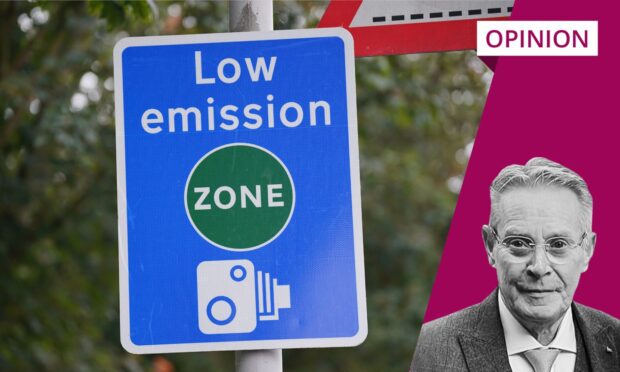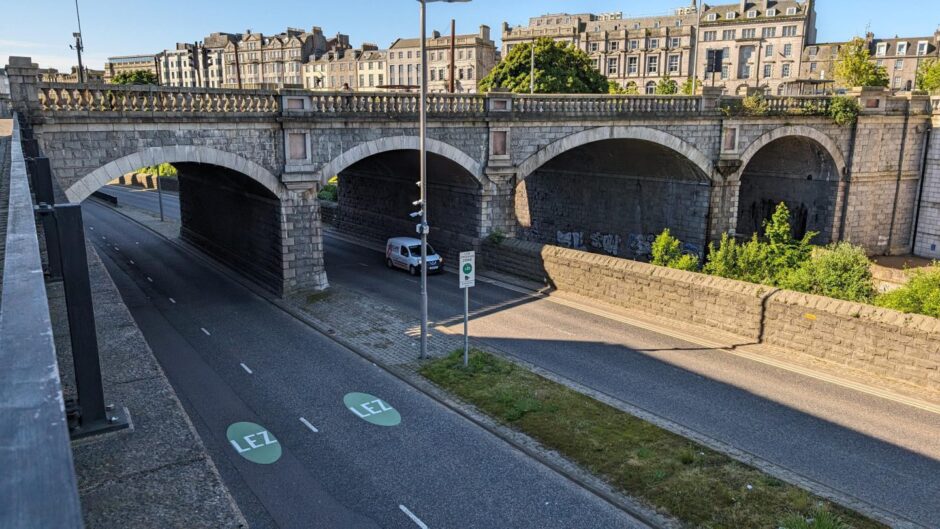I don’t know about you, but I have a funny feeling I’m being watched all the time these days.
Biologically, of course, we are wired to sense when we’re being watched.
It’s evolution: our brains haven’t forgotten the old days.
When someone with a blunt instrument was waiting outside the cave door to bash our brains out.
There is so much our minds get up to subconsciously behind our backs; we’re just not aware of it.
I’ve not done a PhD on the subject or anything, but it seems our brains are often carrying out security sweeps around us like a radar screen on warships.
They do it through peripheral vision, for example.
So if I’m eating a bacon sandwich outside a cafe at Aberdeen beach and something warns me to look up instantly, I see a gull on the roof about to pounce.
LEZ cameras introduced on a confusing array of streets
Talking of being watched, people in Aberdeen must be among the most spied-on in the world right now.
There was a time when the only thing we could get indignant about was CCTV cameras staring at us as we walked about town.
Bus-lane cameras then came along and operated more efficiently than the buses themselves – especially when councils realised how much money they could fleece in fines from drivers.
The era of back-door taxes had arrived to prop-up council finances.
Now we have bus-gate and Low Emission Zone (LEZ) cameras on a confusing array of streets in central Aberdeen to keep many people out.
And a mobile hit squad of council parking enforcers has just been unveiled, too.
The trouble is that trade slumped as wary shoppers and other visitors were driven out – footfall plummeted by thousands.
The city council’s credibility and integrity were rightly brought into disrepute by public and business protesters after rolling out a disproportionate number of measures.
Pushing ahead with minimal democratic process thanks to obscure regulations.
The council was never going to listen because it would face Scottish Government penalties if performing u-turns around the gates.
So for many it deteriorated into an “us and them” relationship with the council – rather than a sensible civic partnership it was supposed to be.
The P&J letters page is an excellent barometer of public opinion.
One recent contributor pilloried the council for treating the bus-gate farce like a game of “Wacky Races”.
Others won’t revisit the city after being trapped by bus-gate cameras.
One poor chap from Inverness was only trying to travel from the west end to Torry.
If his intended role destination was the old Torry Battery military base, I can tell him he needn’t have bothered – this wonderful historical gem looked like a neglected mess on recent visits with my grandchildren.
Even the doors on two portable toilets appeared broken as I watched visitors struggling to close them.
I dread to think what tourists streaming off cruise ships in Aberdeen’s south harbour think of the sight which greets them at the battery.
I’m proud of Aberdeen’s virtues, but it doesn’t become better by rabbiting on incessantly about how good it is; as an old boss berated me decades ago, “it’s what’s wrong which matters most”.
The signs didn’t look good to me.
Low Emission Zone signage is a major issue on Aberdeen roads
Signage also scares drivers brave enough to enter the labyrinthian mystery world of the city’s bus-gate/LEZ crystal maze.
I was impressed when a P&J reporter decided to walk through some of these problem roads to see what the issues were with them.
It reminded me of when I did something similar a couple years ago after being caught in one of the council’s first experimental gates in Union Street.
I couldn’t fathom out why I slipped up.
Walking at snail’s pace it became clear: poor, confusing signage and lack of time to react even at a modest driving speed.
Lo and behold, the reporter’s conclusion was similar.
A day later a P&J survey among drivers using these latest restricted routes was emphatic: poor signage and confusing road layouts.
Years ago I had a company car allowance and was obliged to complete a series of visual reaction tests for drivers via a computer.
To prove I was alert enough to spot a mass of warning signs and potential obstacles.
So much to look out for that I expected to encounter a kitchen sink lying in the road; they’d thought of everything else.
It was like a children’s puzzle book where you have to spot odd objects hiding in a jungle – a pair of scissors here, performing seals there.
But this is possibly the biggest problem with the current restrictions: the sheer volume of extra general traffic signage it has created overwhelms many drivers’ comprehension and is impossible to take in.
No matter how good the brain’s “radar” might be.
Unfortunately, it’s a sign of the times.


Conversation